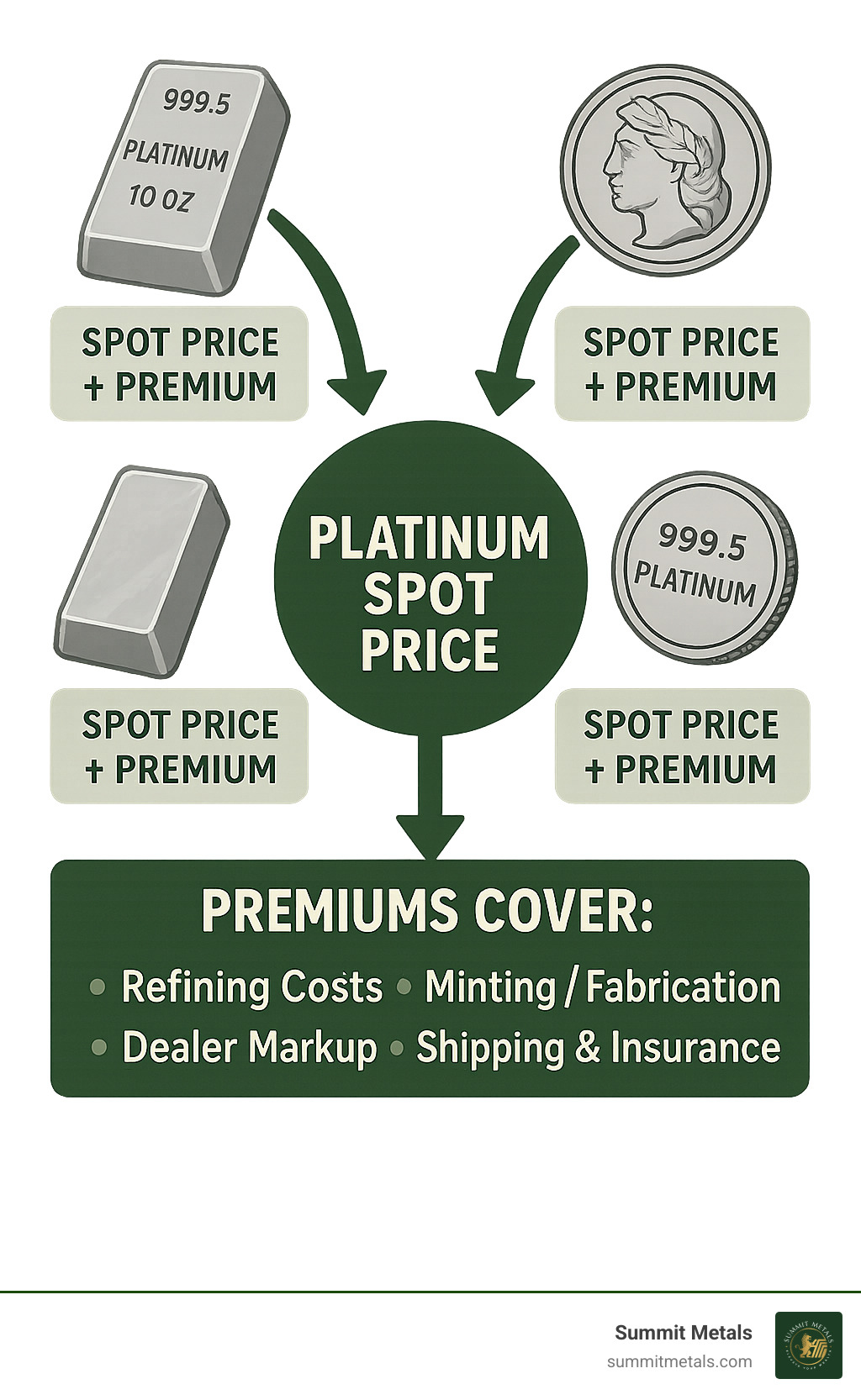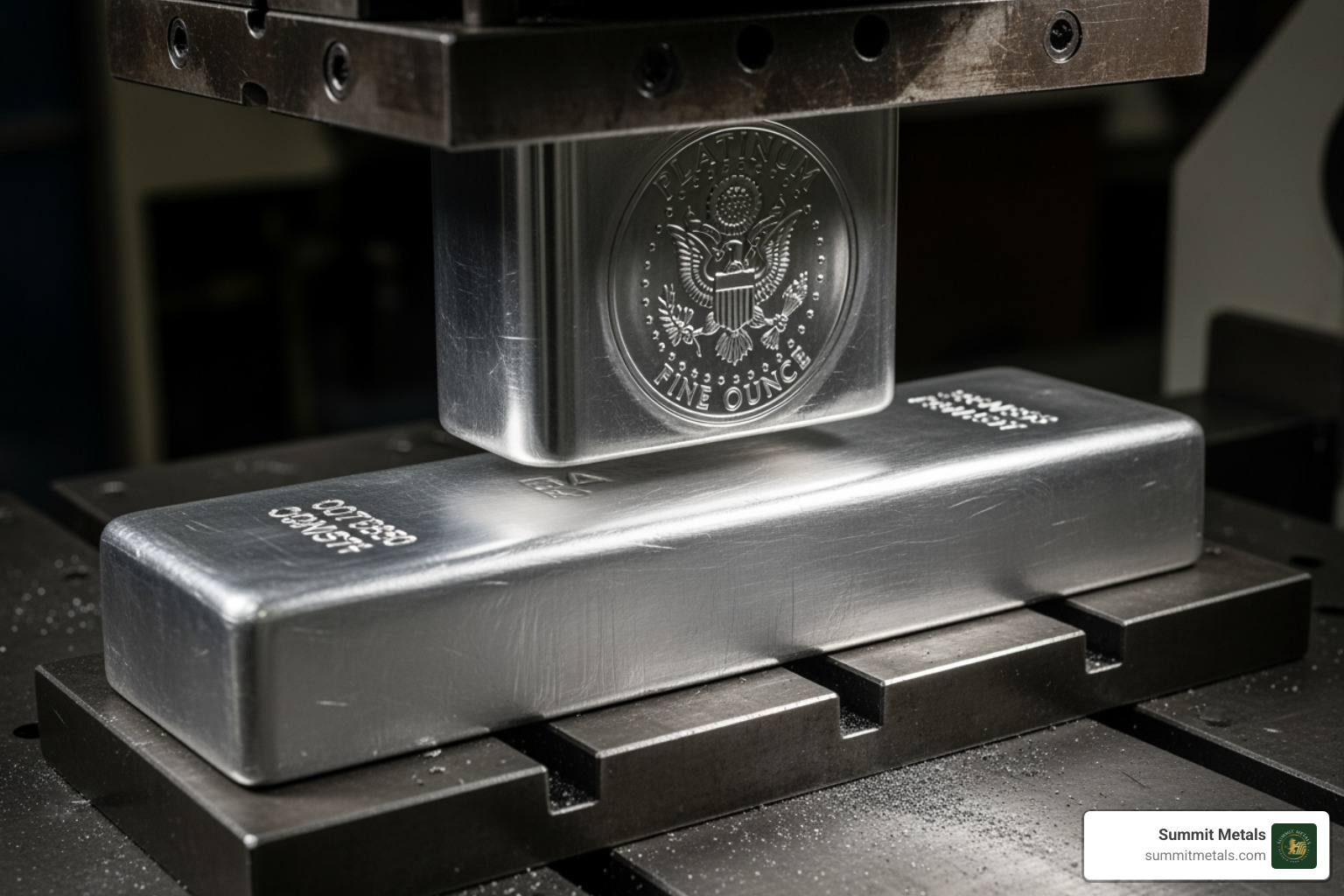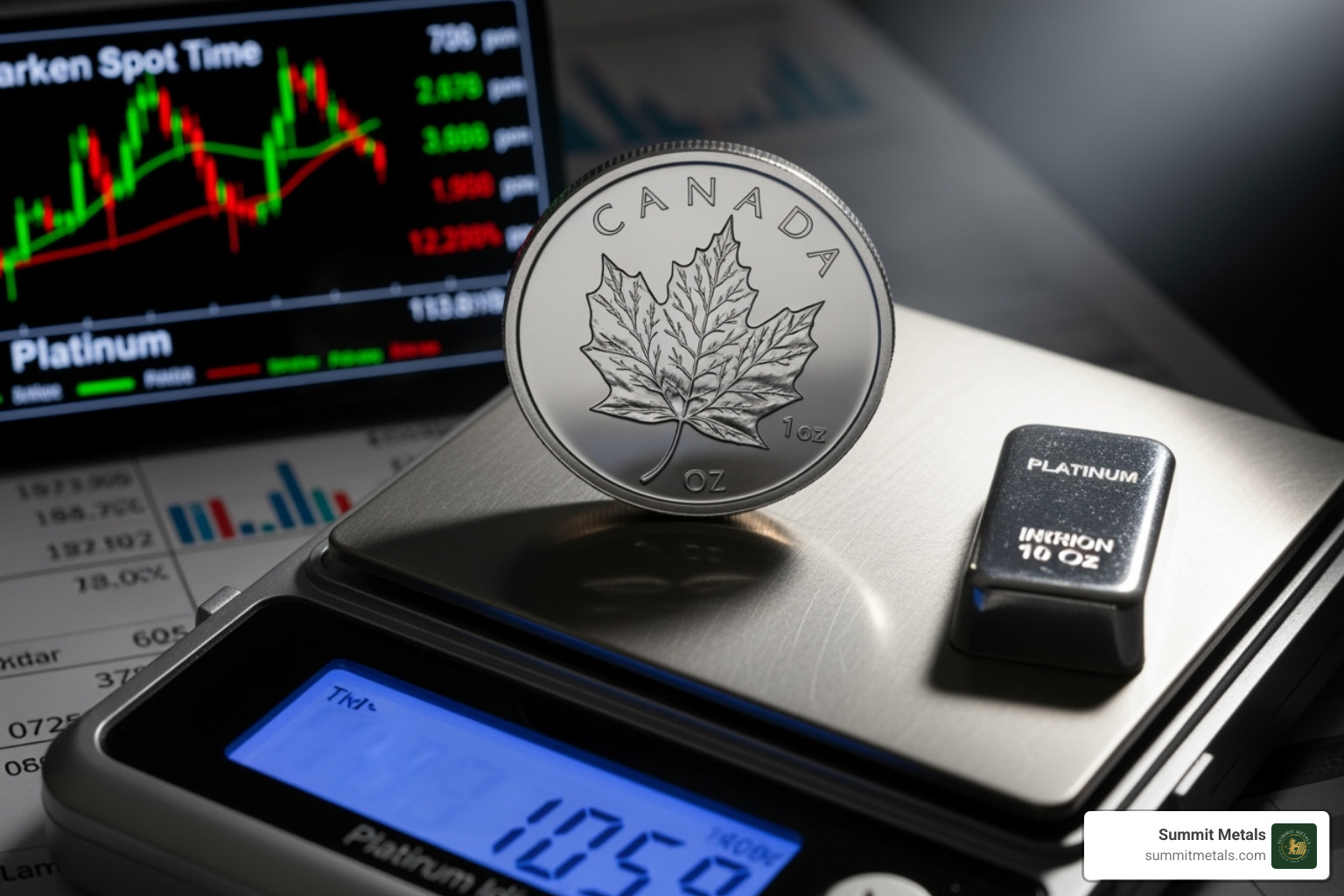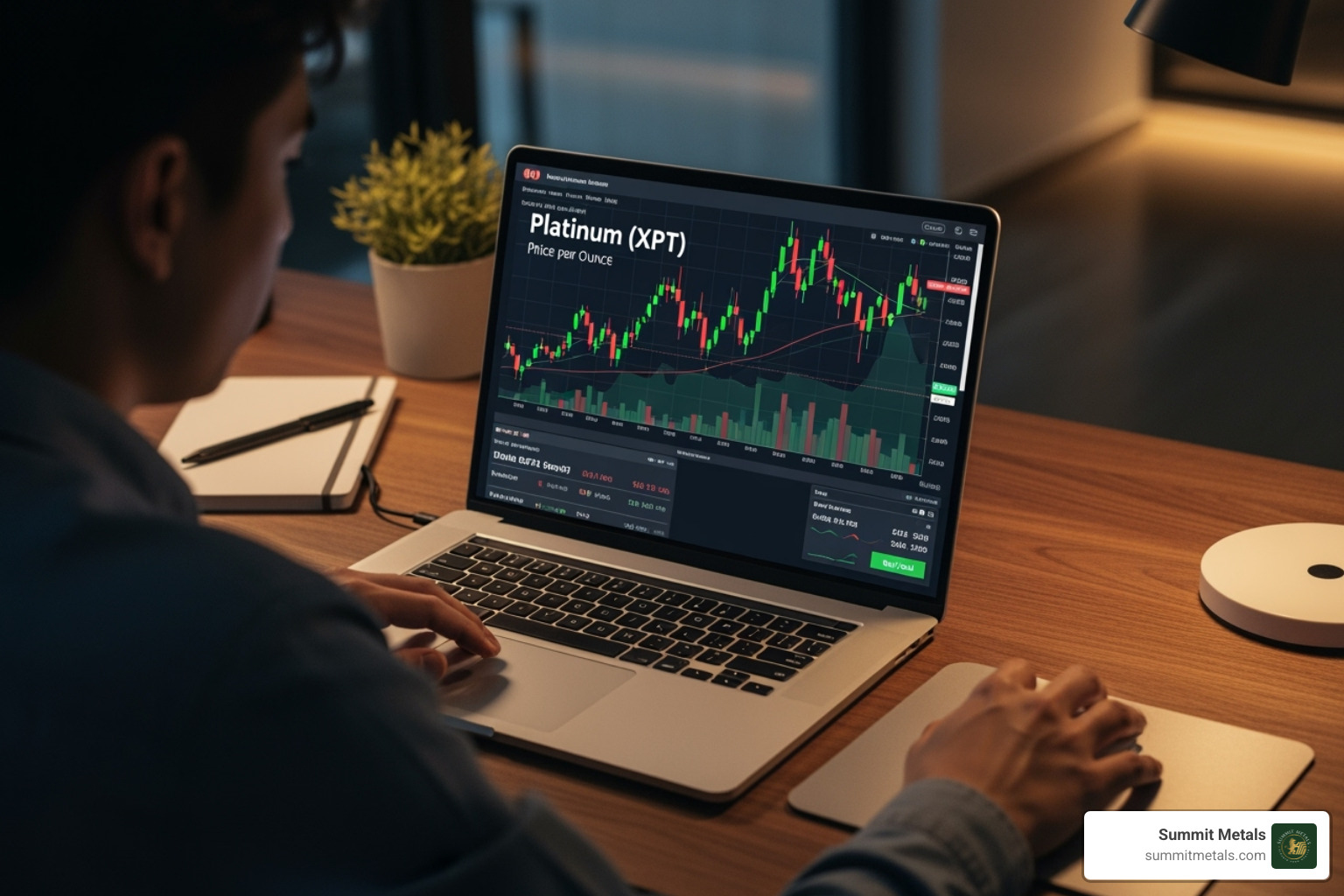Understanding How Platinum Pricing Works
Do platinum coin and bullion follow the spot price? Yes, but not exactly. Platinum coins and bullion track the spot price closely, but they always sell for more than the raw spot price due to premiums that cover production, distribution, and dealer costs.
Quick Answer:
- Spot Price: The base wholesale price of raw platinum
- Physical Products: Spot price + premium (typically 3-15% above spot)
- Premiums Cover: Refining, minting, packaging, shipping, insurance, and dealer markup
- Closer to Spot: Larger bars have lower percentage premiums than coins
- Higher Premiums: Government coins and smaller denominations cost more above spot
When you see platinum's spot price at $1,000 per ounce, you won't pay exactly $1,000 for a physical coin or bar. Instead, you'll pay the spot price plus a premium that reflects the real costs of turning raw platinum into a finished product you can own and store.
This pricing structure exists across all precious metals. The spot price serves as your baseline - it's the global benchmark that moves up and down throughout the trading day. But physical platinum products require additional steps like refining, minting, quality assurance, and secure delivery that add legitimate costs.
Understanding this relationship helps you make smarter buying decisions and avoid overpaying for platinum investments.
I'm Eric Roach. After a decade on Wall Street advising on multi-billion-dollar transactions, I learned how institutional investors approach precious metals. Now, I help individual investors apply those same professional strategies to protect and grow their wealth with physical precious metals.

Understanding Platinum's Spot Price
Before we dive into how physical platinum products get their price tag, we need to understand the bedrock of it all: the "spot price." Think of it as the foundation for every precious metal transaction.
What is the Spot Price of Platinum?
The spot price of platinum is the current market value for one troy ounce of raw, unfabricated platinum, ready for immediate delivery. It's the wholesale price of the metal before it's shaped into a coin or bar. This price is a global benchmark that shifts constantly throughout the trading day. In precious metals, an "ounce" refers to a troy ounce (31.1035 grams), which is slightly heavier than a standard ounce (28.3495 grams).
How is the Spot Price Determined?
The spot price is primarily set by activity in the futures market, where traders buy and sell contracts for the future delivery of platinum. These contracts are traded on major commodity exchanges like the New York Mercantile Exchange (NYMEX) and the London Platinum and Palladium Market (LPPM). The high volume of these trades, even if settled financially, heavily influences the current spot price. You can learn more about what a futures price is.
Beyond the futures market, several other factors shape platinum's spot price:
- Supply and Demand: When demand for platinum outpaces supply, prices tend to rise. Conversely, a surplus can cause prices to fall.
- Economic Indicators: Global economic health, inflation, interest rates, and the strength of the U.S. dollar all influence platinum's price.
- Geopolitical Events: Political instability or conflicts in key producing regions like South Africa (which supplies over 70% of the world's platinum) can cause significant price spikes.
- Industrial Demand: Unlike gold, a large portion of platinum's demand comes from industry, especially for automotive catalytic converters. Changes in this sector heavily impact the spot price.
Understanding these influences is key for any investor. For a closer look at these forces, check out our guide on Key Factors Influencing Gold & Silver Prices: Supply, Demand, Geopolitics. And for a complete picture of how all precious metals pricing works, dive into our guide: More on how precious metals pricing works.
Do Platinum Coin and Bullion Follow the Spot Price? The Role of Premiums
While do platinum coin and bullion follow the spot price in terms of overall movements? Absolutely. But you'll never pay exactly the spot price for a physical coin or bar.

The difference between the spot price and what you actually pay is called the "premium." The spot price is the wholesale cost of raw platinum, while the premium covers everything needed to turn that raw metal into a product you can hold and store.
This premium represents real costs in the supply chain. Several factors influence its size, including supply chain costs, dealer markup, and market volatility. During times of high demand or tight supply, premiums can widen.
Understanding premiums is crucial for making smart investments. Understanding the basics of bullion investing can help you steer these costs effectively.
Why Physical Platinum Costs More Than the Spot Price
Here’s a breakdown of what the premium covers:
- Refining: Purifying raw platinum to investment-grade standards (typically 99.95% pure).
- Minting and Fabrication: Shaping the refined metal into coins or bars using specialized machinery and labor.
- Assaying and Certification: Verifying the weight and purity of the product for quality assurance.
- Packaging, Shipping, and Insurance: Ensuring the product is protected and delivered securely.
- Dealer Overhead: Covering the operational costs of a precious metals business, including secure storage, customer service, and inventory management.
How Premiums Vary for Different Platinum Products
Premiums are not uniform across all platinum products. Understanding these variations helps you make cost-effective choices.
- Product Size: Larger bars have lower percentage premiums because fixed manufacturing costs are spread over more ounces. For example, a 10 oz bar will have a lower premium per ounce than a 1 oz coin. Fractional pieces (e.g., 1/10 oz) carry the highest premiums.
- Product Type: Bars typically have lower premiums than government-issued coins because they are simpler to produce. Coins like the American Platinum Eagle offer benefits like government backing and high recognition, which contributes to a higher premium.
- Fractional Sizes: While they have higher percentage premiums, smaller units offer greater flexibility for future sales. This trade-off is explained in our guide: Why smaller is often better than waiting for a 1oz gold coin.
At Summit Metals, we work to keep premiums competitive through bulk purchasing relationships with major refineries and mints. Our transparent, real-time pricing means you always know exactly what you're paying and why.
Bullion vs. Collectible Coins: Understanding Premiums
When shopping for platinum, you'll find two different worlds: investment-grade bullion and collectible coins. They contain the same metal but have different pricing rules.

Investment-grade bullion (bars, rounds, and most government coins) is valued almost entirely for its metal content. It's designed to track the spot price, making it ideal for investors.
Collectible coins derive value from rarity, condition, and collector demand, often trading for premiums far above their metal value.
For investors asking "do platinum coin and bullion follow the spot price," the answer depends on which category you're buying. Learn about government-issued coins and their role in investing.
Pricing for Platinum Bullion
For investors focused on wealth preservation, bullion is the ideal choice. Its price is driven by these key factors:
- Melt Value: Bullion's price is tied directly to its metal content, with minimal markup for production. The goal is to get as close to the spot price as possible.
- Spot Price Tracking: Bullion prices move in lockstep with the platinum spot price, ensuring your investment's performance directly reflects the market.
- Liquidity: Standard bullion bars and rounds are easy to buy and sell near the spot price, which is crucial if you need to convert your assets to cash. Learn Why liquidity matters when buying precious metals.
- Purity Standards: Investment-grade platinum is typically .9995 fine or higher, a consistent standard that keeps premiums low and liquidity high.
Pricing for Government-Issued Platinum Coins
Government-issued platinum coins are a hybrid of bullion and collectible. While their value is primarily from metal content, other factors can increase their premiums:
- Design and Mintage: Unique designs and limited production runs can attract collector interest, pushing premiums higher than on standard bars.
- Market Demand: Popular coins like the American Platinum Eagle have strong, consistent demand due to their sovereign backing and legal tender status. This recognition adds to investor confidence and the premium.
- Higher Premiums: Expect to pay more over spot for government coins than for generic bars. A bar might have a 5-8% premium, while a popular coin could be 10-15% or more over spot.
Here's how the two categories compare:
| Feature | Bullion Bars | Government-Issued Platinum Coins |
|---|---|---|
| Primary Value | Metal content (melt value) | Metal content + numismatic/collectible value |
| Premium | Generally lower percentage over spot | Generally higher percentage over spot |
| Liquidity | Very high, tracks spot closely | High, but can be slower for rare items |
| Purity | Typically .9995 fine or higher | Often .9995 fine, sometimes 99.9% |
| Purpose | Pure investment, wealth preservation | Investment + collecting, historical interest |
| IRA Eligibility | Yes, if .9995 fine from sovereign mint | Yes, if .9995 fine from sovereign mint |
For investors focused purely on platinum's price performance, generic bullion bars usually offer the most cost-effective way to build a position.
Key Factors Influencing Platinum Prices
Knowing what moves the spot price is critical. Platinum's price dynamics are unique, influenced by its dual role as an investment asset and an essential industrial commodity.
This dual nature makes platinum more volatile than gold. When considering if platinum coin and bullion follow the spot price, it's crucial to understand the forces driving the spot price itself.
Why gold and silver are essential for portfolio diversification provides broader context, but here we'll focus on platinum's unique drivers.
The Impact of Industrial and Jewelry Demand
Unlike gold, over 60% of platinum's demand is industrial, making its price sensitive to economic cycles and technology.
- Automotive Industry: This is the largest consumer of platinum, using it in catalytic converters to reduce vehicle emissions. Car sales trends directly impact platinum demand.
- EV Market and Fuel Cells: While battery electric vehicles (EVs) don't use catalytic converters, platinum is a key component in fuel cell electric vehicles (FCEVs), representing a significant future demand source.
- Jewelry Sector: Accounting for about 30% of demand, platinum is prized for its durability and luster. Luxury consumer trends, particularly in Asia, affect its price.
- Other Industrial and Medical Uses: Platinum is used in chemical refining, glass manufacturing, and electronics. Its biocompatibility makes it vital for medical devices like pacemakers and stents.
Crucially, less than 10% of annual demand comes from investors. This industrial focus makes platinum more volatile than gold but also presents unique opportunities based on supply and demand fundamentals.
How Supply and Geopolitics Affect the Price
Platinum is about 15-20 times rarer than gold, and its supply is highly concentrated, making it vulnerable to disruptions.
- Mining Concentration: Over 70% of the world's platinum comes from South Africa, with Russia as a secondary producer. Events in these regions have a major impact on global prices.
- Supply Disruptions: Labor strikes, political instability, or infrastructure issues (like power shortages in South Africa) can quickly curtail supply and cause prices to spike.
This tight supply situation, with projected deficits through 2027, suggests a strong long-term case for price appreciation. However, these factors also contribute to platinum's higher volatility compared to gold. While gold is a classic safe-haven asset, platinum's price is more closely tied to industrial health and supply chain stability. Learn more about Why Gold and Silver are safe haven assets.
Smart Strategies for Investing in Platinum Bullion
Now that you understand how platinum coin and bullion follow the spot price and what drives those prices, let's discuss smart ways to add platinum to your portfolio. At Summit Metals, our goal is to empower you to make informed choices, lower your costs, and build a solid, long-term precious metals position.

If you're just starting, our beginner's guide to investing in precious metals is the perfect resource.
How Do Platinum Coin and Bullion Follow the Spot Price When Choosing Products?
When choosing products for pure investment, the goal is to minimize premiums while ensuring authenticity and liquidity.
- Common Bullion Coins: Popular options like the 1 oz American Platinum Eagle or Canadian Platinum Maple Leaf are excellent choices. They are highly recognized, easy to trade, and carry reasonable premiums for the benefits they offer.
- Larger Bars: To get the most metal for your money, consider larger bars (5 oz, 10 oz, or 1 kg). They have lower percentage premiums because production costs are spread over more ounces, making them a cost-efficient option for larger investments.
- Focus on Bullion: For investment purposes, stick to standard bullion products rather than collectible (numismatic) coins. Bullion's value is tied directly to the metal's spot price, ensuring you are investing in platinum's performance.
The Power of Dollar-Cost Averaging with Summit Metals Autoinvest
Trying to time the market is nearly impossible. A smarter strategy is dollar-cost averaging (DCA): investing a fixed amount of money at regular intervals, regardless of the price. This approach helps you:
- Average Your Purchase Price: You buy more metal when prices are low and less when they are high, smoothing out your overall cost.
- Reduce Volatility's Impact: DCA minimizes the stress of trying to buy at the perfect moment in a volatile market.
- Build Discipline: It removes emotion from investing and encourages a consistent, long-term habit.
We've made this easy with Summit Metals Autoinvest—Buy Every Month Like a 401k. Our system lets you set up recurring purchases to build your platinum holdings automatically. It's a hands-off, intelligent way to grow your wealth. Find The Power of Dollar-Cost Averaging in Gold and Silver Investments.
Why You Must Buy Platinum Coin and Bullion Through a Trusted Dealer
The safety of your investment depends on who you buy from. At Summit Metals, a trusted dealer based in Wyoming, USA, we prioritize transparency and security.
A reputable dealer provides:
- An Authenticity Guarantee: We have systems to ensure you receive genuine, high-purity platinum, helping you with avoiding counterfeits.
- Transparent Pricing: You should always see the spot price and premium clearly. We are committed to transparent, real-time pricing.
- Secure Transactions: We use safe payment methods and insured shipping to protect your investment from purchase to delivery.
Buying from unverified sources is risky. Our commitment at Summit Metals is to provide competitive rates through bulk purchasing and a secure process, giving you peace of mind. Learn more in our guide on How to Buy Gold and Silver Online Safely.
Conclusion
So, do platinum coin and bullion follow the spot price? Yes, but you'll always pay a premium over the spot price for a physical product. The spot price is the baseline, while the premium covers the real-world costs of production, distribution, and security.
Platinum coins and bullion track the spot price's movements, but the final price reflects the journey from raw metal to a verified, holdable asset.
Key Takeaways for Platinum Investors:
- Spot Price is Your Benchmark: Use the global spot price, driven by industrial demand and supply factors, to gauge fair pricing.
- Premiums are Necessary Costs: Premiums cover refining, minting, shipping, and dealer operations. They are a standard part of buying physical metal.
- Product Choice Impacts Cost: Larger bars generally have lower percentage premiums, while government coins offer high recognition for a slightly higher cost.
- Use Time to Your Advantage: Platinum's volatility is best managed with dollar-cost averaging. Our Summit Metals Autoinvest program lets you buy consistently, like a 401k, to smooth out price swings.
- Trust Your Dealer: Your investment's safety depends on your dealer. At Summit Metals, we guarantee authenticity, transparent pricing, and secure transactions.
Understanding these principles is key to successful precious metals investing. Whether you're just starting or expanding your portfolio, knowledge is your greatest asset.
Ready to invest with confidence? Learn more with our complete guide to bullion investing.





